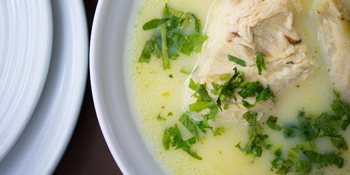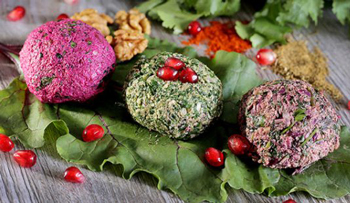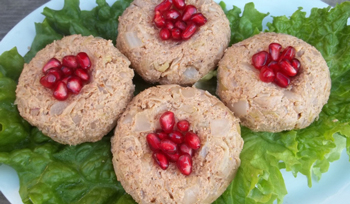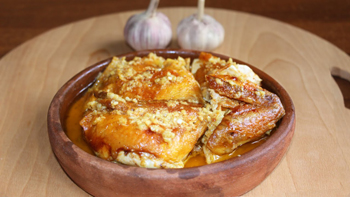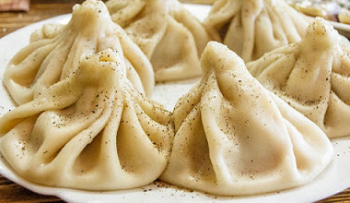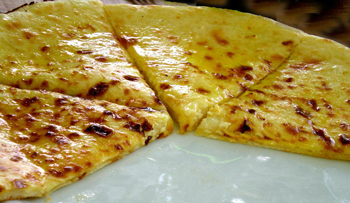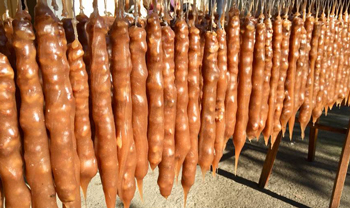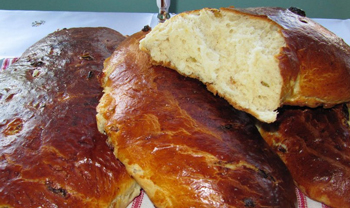|
Georgian Cuisine Georgian cuisine - diverse, fresh and partly exotic A trip to Georgia is worth it in many ways, and Georgian cuisine is an important aspect of it. Characteristics of Georgian cuisine are fresh mountain herbs, variety of exotic spices, delicate cheeses, unusual pasta, different methods of meat preparation and a good combination of fruits and vegetables. To better understand why the cuisine in Georgia is so extraordinarily diverse, a close look at the geographical map is enough. Georgia is located at the crossroads of Europe and Asia, and for centuries it has maintained very close relations with various empires and cultures. It’s also important, that this small country, only about the size of Denmark, is incredibly fertile. Almost everything grows and thrives here, from citrus fruits and tea to pomegranates, figs, kiwis, persimmon fruits, apricots and guavas. A great advantage of Georgian cuisine is, that specialties vary considerably from region to region, so that after a short tour of the country, you will get the feeling of having travelled to several countries. To get better acquainted with the authentic way of Georgian cuisine during a trip, it is recommended to stay in guest houses and in small family hotels and try breakfast and dinner there. They may not be as professionally decorated as the dishes in the restaurant, but when the housewife gets fruits, vegetables and herbs from her own garden or from the farmer's market and lovingly conjures up and serves a dish for her guests, you can taste the difference. Much has been written about Georgian cuisine, but better than hearing or reading about it a thousand times, try it once. You can visit a Georgian restaurant near you, or if you want to eat real Georgian food, come to Georgia, from Europe or Great Brittan it is less than 4 hours flight time. To make it easier for you to choose Georgian specialties, I have compiled a small list of dishes that I personally like the most and if some tasty Georgian specialties are not included, I apologize, but you will surely find something in the list that fits your taste.
Georgian dishes (Names are pronounced exactly as they are written) Soups |
|
Chikhirtma - this tasty appetizer is also called the queen of soups
Ingredients for about 10 portions of chikhirtma Chicken – 1 Preparation 1. boil chicken in water with a little salt. After the chicken is cooked, take it out and sprinkle salt on it, let the broth cool down and keep 1 tea glass of broth separately. 2. chop the onion and roast it well in the pot for the soup until it becomes really yellow and then pour the broth to it. 3. mix the eggs in a separate container together with the remaining glass of broth, sprinkle flour on top and mix again 4. bring the broth to boil with the onions and slowly add the eggs with the flour, then add the vinegar and salt. IMPORTANT: while boiling, after adding the eggs with the flour to the broth, do not stop stirring the broth. Let it boil for about 5 minutes, stirring of course, and at the end add chopped chicken to the broth. Bon appetite! |
|
Fruits and vegetables Pkhali, often called Mkhali, is a traditional Georgian dish of chopped, or ground, vegetables combined with walnut paste, vinegar, onions, garlic, various herbs and spices.
There are several variations of Pkhali. The most popular ones consist of 4 different vegetables: spinach, beet, cabbage and stuffed eggplant rolls. But there are also variations made from carrots and white beans. 1. Pkhali from spinach Portions each for 4 people
Spinach - 1 kg Preparation 1. wash the spinach leaves with cold water, put them into boiling water and cook for about 10-15 minutes (later keep 50 g of broth). Let the spinach dry on the sieve, squeeze out the water well with your hand and chop it into small pieces with a knife. Mix the ground walnuts, garlic, spinach broth, salt, ground red pepper and vinegar. Mix all this with the spinach, as well as with the finely chopped cilantro and onions, forming small balls out of it, for example. Finally, sprinkle with pomegranate seeds and parsley when serving. 2. Pkhali from red beet 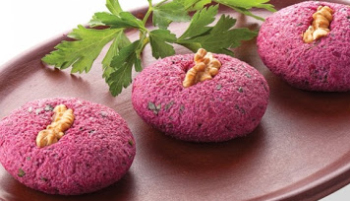
Beet - 1 Kg 1. Boil beet well, cool, cut into small pieces and grind in a blender. 3. Pkhali from cabbage Cabbage - 500 g Preparation 1. put cabbage cut into 4 parts into boiling water and cook for about 10-15 minutes. Then let the cabbage dry on the sieve, squeeze out the water well with your hand and chop the cabbage into small pieces with a knife. Mix the ground walnuts, garlic, salt, ground red pepper, Khmeli Suneli and vinegar. Then mix all this with the cabbage cut into small pieces, for example, make small balls out of it. Finally, sprinkle pomegranate seeds on top when serving. 4. Stuffed eggplant rolls
Ingredients Eggplants - 1 kg. Preparation 1. wash the eggplant, peel it and cut it lengthwise into thin slices (about 5mm), sprinkle with salt on both sides and let it stand for 30 minutes 2. fry the eggplants in a pan with enough oil, or spread them on a baking tray covered with baking paper and bake at 180 degrees for 10 to 15 minutes 3. in the meantime, finely grind the walnuts in a blender, add the rest of the ingredients and blend to a puree 4. take the eggplant strips out of the oven and let them cool down a bit. Then spread a tablespoon of walnut paste on each of the strips and roll/fold them up. 5. garnish rolled eggplant with pomegranate seeds and parsley and serve. Meat dishes 1. Mtsvadi (meat on a skewer) - the original form of all types of Shashlik. Portion for 3 to 4 people
Ingredients Pork neck (or beef tenderloin) not too lean - 1 kilogram Preparation 1. Wash the meat, cut it into large pieces (slightly smaller than the palm of your hand) and place in a bowl. Add salt and pepper and stir well. Next, roughly chop 2 onions and squeeze the juice well. Add the onion juice, as well as the squeezed onions to the meat, stir everything again and finally add the red wine. Once again mix everything well, cover tightly and let it sit for about 1 hour. In the meantime, prepare the fireplace. Light the vine without alcohol and wait until it becomes hot embers, then lay stones or bricks on the side for the skewer. 3. 3. Skewer the meat and place the skewers on the prepared stones, with a distance between the embers and the skewer of about 20 cm. Important to pay attention during grilling to regulate the fire on the meat with the diluted vinegar water. According to East Georgian method, where the Mtsvadi originally comes from, the skewers should be roasted medium. 4. While grilling, prepare the pot for the finished Mtsvadi: Cut 2 onions into rings and spread the rings in the pot. 5. With the help of a piece of pita bread (preferably bread baked in clay) pull the grilled meat from the spit directly into the pot with the onions. The bread you used goes in with it. Cover the pot well and wrap it with a cloth. Now comes the trick: take the pot by the handles and shake several times. Wait about 2 minutes, remove the lid and Gaamot! (Bon appétit!) A well grilled Mtsvadi is very juicy and did not need additional sauces. 2. Chakapuli of lamb meat
Ingredients Preparation 1. wash/cut the meat (about 3 cm in size) and divide into 4 portions. Proceed the same way with the next layers of meat and spice mixture until all 4 portions are in the pot. As soon as the water starts to boil stir everything and add salt to taste. Let everything cook for a few more minutes and when the meat is cooked, the dish is also ready. Shqmeruli - the birthplace of this specialty is a small village called Shqmeri, in the Racha region of northern Georgia
Ingredients Chicken - 1 kg Preparation 1. thoroughly wash the chicken inside and out and pat dry. Remove any remaining quills. Cut off excess fat. Rub chicken well all over with salt. Heat clarified butter well in pan, place chicken breast side down in pan and brown. If the meat sticks to the bottom of the pan, do not remove it by force, but wait: when the frying is ready, it will come off by itself. Turn chicken and sear on the other side. When the chicken is well fried, place it in a separate bowl, a keci (clay bowl) is best. 3. in the pan, in the remaining fat where the chicken was fried, lightly fry the crushed garlic and add the milk, cook for 2 minutes and put the chicken back in. Turn off the heat, cover the pan tightly and let it cool/steep for about 5 minutes. Then put the chicken with all the sauce in the bowl where the chicken was before and enjoy. Gaamot:) *** If you can't tolerate milk, you can use water, yogurt or cream instead. |
|
Pasta Khinkali - Georgian dumplings There are now many variations of Khinkalis: with potatoes, mushrooms, cheese, cottage cheese and so on. But I would like to present you the classic Khinkalis. Short introduction: Khinkali is a dish from the mountains of North Georgia, where because of the altitude few herbs grow, where also very rarely pigs are kept, so this specialty in the mountains is prepared mainly from lamb meat, sometimes a mixture of lamb and beef, with very few herbs and spices. In the restaurants you usually get a richly spiced mixture of beef and pork.
Ingredients for approx. 50 pieces Minced beef & lamb mixed, or lamb only. In any case, the meat should have a little fat Preparation 1. preparation of the dough Knead 900 g of flour with water and salt (1 tsp) to a dough, cover well and let it rise for 30 minutes. Knead the dough again and let it rise again for 30 minutes, repeat the whole process 3 to 4 times. The harder the dough the better. It is best to prepare the dough the night before. 2. preparation of the filling Chop the meat with the onions (this is often done with a small axe) and put it in a bowl, add real caraway seeds, salt and black pepper and mix well, then pour cold water 0.5 litres and mix well again. 3. roll out dough evenly about 1 cm thick and cut out circles 5 cm in diameter. Turn out dough disks in flour and roll out individually 1 mm thick. When finished, the dough discs should be 10-12 cm in diameter. 4. 4. using a teaspoon, place the filling in the centre, fold up the edges of the dough and fold all around, finally pressing them together in the centre to form a stick. (There is no consensus on how many folds a "proper" Khinkali should have, many feel that about 19 folds is sufficient). 5. Bring the water to a boil in a large, wide-bottomed pot and add salt. Add rolled up Khinkalis one at a time, upside down with the stem facing down, to the pot and stir very gently with a wooden spoon several times. Cook for about 15 minutes, stirring gently two or three times to prevent the Khinkali from sticking to each other or to the bottom. Then carefully remove from water, serve immediately hot, steaming and season with black pepper. *** Important: Khinkalis are not eaten with a fork and knife, but by hand. 2. Megruli khachapuri - Khachapuri megrelian type. Similar to Khinkali, there are also different varieties of Khachapuri. There are differences here not only in the filling, but also in the shape and ingredients. The most popular khachapuri varieties are: Imeruli, Acharuli and Megruli, all 3 are names of respective regions: Imereti, Adjaria and Samegrelo. All 3 are very tasty, but my favorite variety is the Megruli Khachapuri, meaning a khachapuri variety that is common in the Samegrelo region, in the west of the country, so I offer you the recipe exactly from this variety. Megruli Khachapuri differs from its relatives of the same name in that a double layer of cheese is used in cooking - inside and outside. As a result, you get a very tasty, crispy crust and juicy filling.
Ingredients for the dough Ingredients for the filling Soft cow cheese with little salt - 300 g Preparation of the dough 1. In the warm milk (or water), add yeast and sugar and let stand for 15 minutes. Preparation of the filling and the top layer 1. Grate soft cheese well in a large grater and mix. Baking 1. roll out the dough 0.5 cm thick, form the filling into a ball and place it in the center of the dough. Then gather the dough from the edges to the center, pressing out the air from the inside, tear off the knot at the end and roll out the resulting dough pocket evenly about 1 cm thick. Dessert Churchkhela - A traditional delicacy made of grape juice and walnuts Besides being a particularly tasty snack, churchkhela is also very healthy for the heart and brain, so Georgian grandmothers recommend their grandchildren to always have a piece of churchkhela with them during exams. It is not quite easy to prepare this specialty, but the result is worth every effort.
Ingredients for 4 churchkhelas Cracked walnuts - 50 pieces or hazelnuts - 100 pieces Preparation of walnuts 1. lightly roast walnuts/hazelnuts in a pan for about 2 to 3 minutes Preparation of the grape juice 1. put wheat flour in a bowl, slowly pour 0.5 liters of grape juice, stirring with a wooden spoon, then mix well with a mixer. Then lower fire and simmer on low temperature for 10 minutes, stirring constantly. The juice becomes so thick that it drips from the spoon very slowly and viscously Next step 1. dip the nut chain into the juice, holding the thread with one hand and with the other hand, press the nut chain down with a spoon so that the liquid is evenly distributed. It is helpful if a second person continues to stir the juice continuously while doing this. 2. Pull nut chain out of juice, hang it up, and dip the next chain into the juice. Churchkhelas should be hung side by side so that they do not stick to each other. Leave in a well-ventilated place to dry. 3. After 2 days, take down the Churchkhelas, which are still quite soft, re-prepare the juice and dip them again one by one and hang them up again. Now your churchkhelas are ready and just need to dry well for 10 to 15 days. 4. After Churchkhelas are dried, you can taste them, wrap the rest well so that they do not dry out completely. So, they can be stored up to one year. Nazuqi - one of the oldest Georgian sweets, which in earlier times was prepared at Easter, but today is baked much more often. The tastiest Nazuqis are baked in a clay jar on fire, but you can bake them quite well in an oven.
Ingredients for 4 Nazuqis Wheat flour - 600 g Preparation in the oven 1. Dissolve yeast in the warm milk and let it rest for about 15 minutes 2. Sugar also, dissolve in a separate bowl in the warm milk and butter. 3. Add to the wheat flour egg, milk with yeast, and milk with butter/honey and other ingredients, such as yogurt, cinnamon, vanilla and start kneading, moistening your hand frequently with oil, after about 10 minutes the dough will be elastic and not sticky, about like bread dough, only a little softer. Then mix the dough with raisins, cover well and put in a warm place to rise. Unlike bread dough, Nazuqi dough should be left to rest longer, about 5 hours, kneading 4 to 5 times. 4. Divide the dough into 4, roll up individually into strands about 1.5 cm thick in the shape of a crescent, cover with a damp cloth and let rest for 30 minutes. 5. Transfer Nazuqis on the baking sheet, brush with egg and put in the preheated oven. Bake at 200 C°. Bake for about 20 minutes. 6. Remove baked Nazuqi from oven, break off with hand and serve warm with strawberry jam. |
|
Georgian herbs and spices For a better idea of Georgian cuisine and typical dishes, but also so that you can eventually cook something Georgian yourself later, I have compiled here a small list of the most commonly used spices and herbs in Georgian cuisine: 1. Coriander – Qindzi
|

